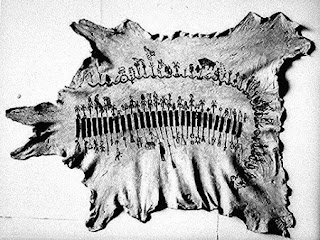Native Life: Winter Counts
Societies throughout time have used various methods of computing passing years in order to date certain events. In ancient times, the years of each ruler's reign provided a handy reference. Mesoamerican civilizations made calendars based on observations of the stars and celestial phenomena. Europeans counted years from the reputed date of Jesus Christ's birth. Native Americans in western North America also had a time-computation system that worked for them. Many tribes calculated each year from the first snowfall to the first snowfall of the following year. Each year was assigned a pictograph, and an assigned tribal elder would draw that pictograph on a buffalo hide. Later, when buffalo became scarce, muslin, paper or other materials were used. Based on a consensus with other tribal elders, a descriptive name would be assigned to that year. For example, the year the stars fell might refer to a year with a significant meteor shower. This method of computing time is associated with the Lakota/Sioux, but a similar system was used by the Blackfoot, Kiowa, Mandan and other tribes. Surviving hides filled with pictographs still exist in museums.




Comments
Post a Comment